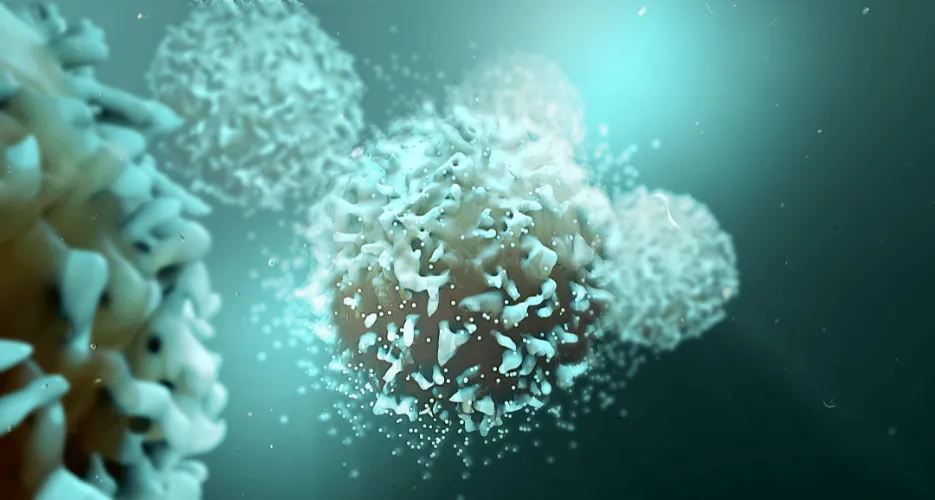How One DLBCL Therapy Is Proving Its Worth: Three Years Later

TRANSFORM is a randomized, multi-center trial that studied relapsed or refractory DLBCL patients to compare the safety and efficiency of the standard of care chemotherapies vs. the use of lisocabtagene maraleucel (liso-cel), and new and promising therapy for the field.
The 3 year follow-up to this study was presented at a research conference, the American Society of Oncology (ASCO) earlier this year.
What Is Lisocabtagene Maraleucel?
Liso-cel is an autologous (taken from an individual’s own tissues or cells) CAR-T product that targets a protein on the surface of cells called CD19. This therapy works by using the body’s own white blood cells to fight the cancer cells. Common side effects of this treatment include fatigue, a serious immune reaction known as cytokine release syndrome (CRS), muscle pain, edema (swelling), headache and decreased appetite.
Despite these side effects, it is a treatment with a lot of promise, getting DLBCL researchers and physicians excited about the future.
What Is The TRANSFORM Study?
Originally completed in 2023 (NCT03575351), this phase 3 study showed that liso-cel offered patients significant improvement vs. standard of care (R-DHAP, R-ICE, or R-GDP).
The trial involved 184 patients and found that those treated with liso-cel had a much longer period of event-free survival (meaning the cancer didn’t progress or return) compared to those who received the standard chemotherapy and stem cell transplant approach (10.1 months versus 2.3 months).
The study also looked at safety and found that while both groups had side effects like low blood counts, the risks were generally manageable with liso-cel. Notably, serious side effects related to CAR T-cell therapy, like cytokine release syndrome and neurological issues, were rare and no treatment-related deaths were reported in the liso-cel group.
Patients receiving liso-cel first went through lymphodepletion, which is a process that prepares the body and immune system for the CAR T-cell therapy, helping the infused cells work better. After that, they received liso-cel (a dose of CAR T-cells designed to target the cancer). On the other hand, standard treatment patients received three cycles of chemotherapy (R-DHAP, R-ICE, or R-GDP), and those who responded to this treatment moved on to a stem cell transplant.
The study found that patients treated with liso-cel had a longer response to treatment compared to those on standard therapy. In fact, 66% of patients who started with standard care ended up switching over to liso-cel. Unfortunately, deaths were more common in the standard treatment group.
Overall, this trial supports using liso-cel as a new second-line treatment for patients with early relapsed or refractory LBCL, offering better outcomes than the current standard of care.
3-Year Follow-Up
In the initial analyses of the TRANSFORM study, researchers already knew that liso-cel (a CAR T-cell therapy) showed significantly better outcomes compared to the standard of care (SOC) for patients with relapsed or refractory large B-cell lymphoma (LBCL). Liso-cel improved event-free survival (EFS), progression-free survival (PFS), and response rates compared to the standard chemotherapy and stem cell transplant treatments.
After three years of follow-up, they learned several key things:
- Continued Improvement: The benefits of liso-cel not only persisted but also deepened over time. Patients on liso-cel had longer durations of response and better survival outcomes compared to the SOC group.
- Crossover Impact: 66% of patients in the SOC group ended up switching to liso-cel, and their outcomes were included in the analysis. Even after the switch, the overall survival (OS) rates were numerically higher for the liso-cel group.
- Survival Rates: After three years, median overall survival was still not reached for either group, indicating that many patients were still alive, but the liso-cel group showed higher survival rates.
- Deaths and Safety: The safety profile remained consistent with the earlier findings, and most deaths (in both groups) were due to disease progression. Importantly, liso-cel continued to show a manageable safety profile without any new concerns.
Stay Up-to-Date with DLBCL News
If you want to learn more about DLBCL treatment advances and other news, sign up for our newsletter!
Sources:
- Lisocabtagene maraleucel versus standard of care with salvage chemotherapy followed by autologous stem cell transplantation as second-line treatment in patients with relapsed or refractory large B-cell lymphoma (TRANSFORM): results from an interim analysis of an open-label, randomised, phase 3 trial
- A Study to Compare the Efficacy and Safety of JCAR017 to Standard of Care in Adult Subjects With High-risk, Transplant-eligible Relapsed or Refractory Aggressive B-cell Non-Hodgkin Lymphomas (TRANSFORM)
TRANSFORM is a randomized, multi-center trial that studied relapsed or refractory DLBCL patients to compare the safety and efficiency of the standard of care chemotherapies vs. the use of lisocabtagene maraleucel (liso-cel), and new and promising therapy for the field.
The 3 year follow-up to this study was presented at a research conference, the American Society of Oncology (ASCO) earlier this year.
What Is Lisocabtagene Maraleucel?
Liso-cel is an autologous (taken from an individual’s own tissues or cells) CAR-T product that targets a protein on the surface of cells called CD19. This therapy works by using the body’s own white blood cells to fight the cancer cells. Common side effects of this treatment include fatigue, a serious immune reaction known as cytokine release syndrome (CRS), muscle pain, edema (swelling), headache and decreased appetite.
Despite these side effects, it is a treatment with a lot of promise, getting DLBCL researchers and physicians excited about the future.
What Is The TRANSFORM Study?
Originally completed in 2023 (NCT03575351), this phase 3 study showed that liso-cel offered patients significant improvement vs. standard of care (R-DHAP, R-ICE, or R-GDP).
The trial involved 184 patients and found that those treated with liso-cel had a much longer period of event-free survival (meaning the cancer didn’t progress or return) compared to those who received the standard chemotherapy and stem cell transplant approach (10.1 months versus 2.3 months).
The study also looked at safety and found that while both groups had side effects like low blood counts, the risks were generally manageable with liso-cel. Notably, serious side effects related to CAR T-cell therapy, like cytokine release syndrome and neurological issues, were rare and no treatment-related deaths were reported in the liso-cel group.
Patients receiving liso-cel first went through lymphodepletion, which is a process that prepares the body and immune system for the CAR T-cell therapy, helping the infused cells work better. After that, they received liso-cel (a dose of CAR T-cells designed to target the cancer). On the other hand, standard treatment patients received three cycles of chemotherapy (R-DHAP, R-ICE, or R-GDP), and those who responded to this treatment moved on to a stem cell transplant.
The study found that patients treated with liso-cel had a longer response to treatment compared to those on standard therapy. In fact, 66% of patients who started with standard care ended up switching over to liso-cel. Unfortunately, deaths were more common in the standard treatment group.
Overall, this trial supports using liso-cel as a new second-line treatment for patients with early relapsed or refractory LBCL, offering better outcomes than the current standard of care.
3-Year Follow-Up
In the initial analyses of the TRANSFORM study, researchers already knew that liso-cel (a CAR T-cell therapy) showed significantly better outcomes compared to the standard of care (SOC) for patients with relapsed or refractory large B-cell lymphoma (LBCL). Liso-cel improved event-free survival (EFS), progression-free survival (PFS), and response rates compared to the standard chemotherapy and stem cell transplant treatments.
After three years of follow-up, they learned several key things:
- Continued Improvement: The benefits of liso-cel not only persisted but also deepened over time. Patients on liso-cel had longer durations of response and better survival outcomes compared to the SOC group.
- Crossover Impact: 66% of patients in the SOC group ended up switching to liso-cel, and their outcomes were included in the analysis. Even after the switch, the overall survival (OS) rates were numerically higher for the liso-cel group.
- Survival Rates: After three years, median overall survival was still not reached for either group, indicating that many patients were still alive, but the liso-cel group showed higher survival rates.
- Deaths and Safety: The safety profile remained consistent with the earlier findings, and most deaths (in both groups) were due to disease progression. Importantly, liso-cel continued to show a manageable safety profile without any new concerns.
Stay Up-to-Date with DLBCL News
If you want to learn more about DLBCL treatment advances and other news, sign up for our newsletter!
Sources:
- Lisocabtagene maraleucel versus standard of care with salvage chemotherapy followed by autologous stem cell transplantation as second-line treatment in patients with relapsed or refractory large B-cell lymphoma (TRANSFORM): results from an interim analysis of an open-label, randomised, phase 3 trial
- A Study to Compare the Efficacy and Safety of JCAR017 to Standard of Care in Adult Subjects With High-risk, Transplant-eligible Relapsed or Refractory Aggressive B-cell Non-Hodgkin Lymphomas (TRANSFORM)

about the author
Lisa Foster
Lisa Foster is a mom of 3 daughters and 1 perfect grandchild, a puzzle lover, writer and HealthTree advocate. She believes in the mission of the foundation and the team that builds it forward. She calls Houston, Texas home.
More on Treatment Advances
Trending Articles
Get the Latest Lymphoma Updates, Delivered to You.
By subscribing to the HealthTree newsletter, you'll receive the latest research, treatment updates, and expert insights to help you navigate your health.
Together we care.
Together we cure.
3x Faster.









